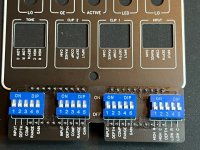jeffwhitfield
Well-known member
Hey folks,
So, I'm in the middle of finalizing a Muffin Factory build. However, while putting together the DIP switch board, I discovered what could potentially be a colossal f#$%-up. Seems the switch assignments don't line up with the labels on the faceplate. So...did I screw up and install the DIP switches and pin headers on the wrong side? Seemed logical to install the DIP switches on the printed side. I'm super concerned about soldering these on the board if they're not correct. Way, way too hard to desolder these off the DIP switch board as it is...definitely don't want to add to the pain.

So, I'm in the middle of finalizing a Muffin Factory build. However, while putting together the DIP switch board, I discovered what could potentially be a colossal f#$%-up. Seems the switch assignments don't line up with the labels on the faceplate. So...did I screw up and install the DIP switches and pin headers on the wrong side? Seemed logical to install the DIP switches on the printed side. I'm super concerned about soldering these on the board if they're not correct. Way, way too hard to desolder these off the DIP switch board as it is...definitely don't want to add to the pain.



